► Battle of the super-saloons
► BMW M5 or Mercedes-AMG E63?
► Twin test by CAR magazine
With each new generation of the M5 super-saloon, so BMW’s M Division slaughters another sacred cow. The fourth-generation E60 dropped the manual gearbox for SMG, the fifth-generation F10 swapped natural aspiration for turbocharging, and now the M5 wanders once more unwittingly into the abattoir, its previously crucial rear-wheel drive swiftly given a bolt to the head.
Other than the X5 and X6 M models (more unholy squealing slaughter), it makes this sixth-generation F90 M5 the first ‘true’ M car to be fitted with all-wheel drive. Sacrilegious, or the key to driving nirvana? We’re about to find out. One thing’s for sure, though: the introduction of so-called M xDrive also means that, for the first time, the battle between the BMW M5 and its Mercedes-AMG E63 rival is fought on completely equal terms. It promises to be quite the showdown.
Buying guide: we drive every previous generation of BMW M5
Both manufacturers’ super saloons field automatic gearboxes and all-wheel drive to clean up after the devastation wrought by twin-turbocharged V8 powerplants. That translates as 592bhp and 553lb ft from the M5’s 4.4-litre V8, enough for a 3.4-second 0-62mph time that’s some 1.2sec up on the previous model. That’s despite having only 40bhp more on tap, so already the stats are reaping the benefits of M xDrive. The Mercedes E63 S, by comparison, turns in a slightly superior 604bhp and significantly superior 627lb ft from its smaller 4.0-litre V8, but delivers the same 0-62mph result.
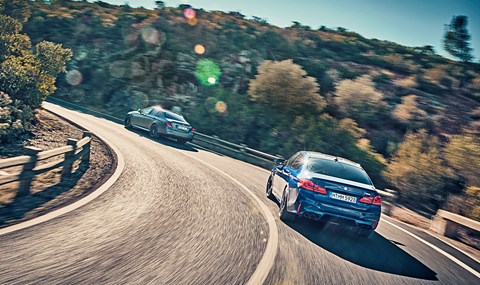
The bang-per-buck prize falls to the Mercedes, though: the M5 is yours from £89,640, while the entry-level E63 (with 563bhp) costs a whisker under £80k. Our top-spec E63 S increases the price of entry to £87,375. Reasons to go plural include the S’s 39bhp/74lb ft upgrade, plus dynamic engine mounts, electronically controlled locking rear diff, and larger brakes. And it’s only the E63 S that gets rear-drive Drift mode.
All of which seemed a good enough reason to get the two together ahead of the M5’s press launch, putting the all-wheel-drive M under the microscope against a car we already know does the business.
Despite familiar looks and an engine that’s essentially an evolution of the BMW’s old 4.4-litre V8, there’s more than just all-wheel drive to report for the M5. That engine gets new turbos, extra fuel-injection pressure and modified manifolds, and the seven-speed dual-clutch gearbox is kicked into touch in favour of a more conventional eight-speed auto. The front track is wider, the roof now made from carbonfibre, and weight drops a fraction despite the all-wheel-drive hardware.
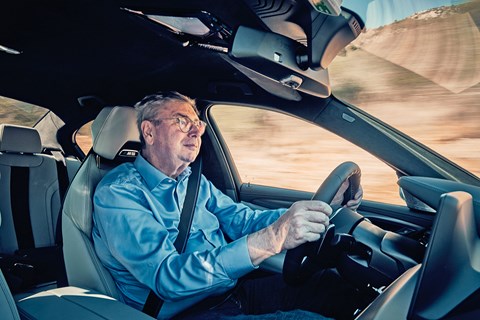
But it’s those extra front driveshafts that are most controversial. It’s not that the loyal M5 customer suddenly forgot how to handle this much grunt. Fact is, the rear-wheel-drive aficionados have long been in the minority, and the M boys should have seen this coming. In fact, M Division refused to adopt this crucial enhancer of safety and controllability until Frank van Meel, former head of Audi Sport, took charge.
Has he made an M5 for sissies, we tease? ‘Not at all,’ says the man behind project F90. ‘All-wheel drive makes the new M5 faster, sharper and safer. Thanks to improved traction and stronger lateral grip, especially on low-friction surfaces, it allows you to carry more momentum out of corners.’ And, as we’ll see, you can still get your rear-wheel-drive kicks on demand, in both super saloons.
Browse used BMW 5-series for sale
Right now, though, we’re happy to let all four wheels do the driving. In late autumn, the weather on the Portuguese Atlantic coast is still sunnier than on most summer weekends in Brighton. Due to the long absence of rain, the dust-dry tarmac is sanded down to the primer, grip reminiscent of a puck on an air-hockey table. Even with all electronic watchdogs on full alert, the rear ends of these saloons on steroids keep wriggling, fidgeting and twitching under pressure. This hornets-in-the-underpants conduct is to an extent augmented by the ultra-high-performance tyres.
After all, both the Pirelli P Zeros (BMW: 275/35 ZR20, 285/35 ZR20) and the Continental SportContacts (Mercedes: 265/35 ZR20, 295/30 ZR20) need a hot, grippy surface to demonstrate their superglue talents. That’s grippy and hot like at the Autodromo do Estoril where you can brake car lengths later and step back on the gas seconds earlier than on the winding E10-1 public highway. According to the official data sheets, the E63 S weighs 1880 kilos and is thus only a token 25 kilos heavier than the new M5. Yet first impressions after a couple of spirited laps reveal that the all-in BMW does indeed feel a tad lighter and thus a tick more agile than the fully loaded Mercedes-AMG.
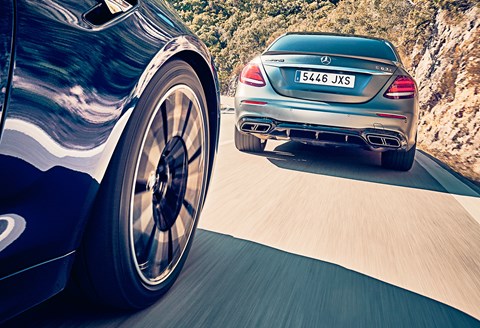
The BMW’s M xDrive system works well, and uses a transfer case to take care of the fully variable north-south torque split, while the M differential masterminds the east-west distribution across the rear axle. If that sounds like it covers all bases, M xDrive is highly configurable far and beyond that basic premise. Those who prefer an extra portion of tail-happiness are invited to activate the M Dynamic Mode (MDM) with 4WD Sport, thereby casting a wider-meshed safety net and diverting more torque to the rear wheels.
The next step on the way to the golden oversteer diploma is triggered by a stab at the DSC button. As soon as the yellow warning light comes on, the M xDrive menu offers three choices: 4WD, 4WD Sport and 2WD. Yes, things are beginning to get a bit complicated now, and that’s even before you start playing with the staggered steering, suspension and drivetrain settings and their Comfort, Sport and Sport Plus modes.
The new M5 is at its very quickest around a racetrack with no DSC guardian angel and with 4WD Sport selected. The exit speed out of fast corners is absolutely mind-boggling, the underlying rear bias remains a factor all the way into triple digit terrain, and traction and grip are simply extraterrestrial. Says Frank van Meel: ‘What sets our system apart is the single ECU to control both diffs, plus the stability and traction control and ABS algorithms. This application is so much quicker than the usual CAN bus convoys.’ In rear-drive mode, old habits come through loud and clear, the M5 able to pull lurid slides just like the good old days of traction limitations.
Irrespective of the fact that M5 and E63 S are aimed primarily at older and wealthier image-conscious customers, neither BMW nor Mercedes seems to put a particular emphasis on classic luxury-car values such as comfort or amenities. Instead, satisfying the urge to play appears to be the number-one priority. But before these two wild things can burn rubber, we must first punch in the correct settings. So while one hand holds tight to the wheel, the other is busy pushing, twisting, scrolling, touching and zooming, thereby diverting the driver’s attention from the road to the centre stack. The more hardcore your ambition, the deeper you must dive into each car’s menu underworld.
This anything-goes philosophy is the driving force behind new features like the Drift mode introduced in the S version of the E63. Even though all previous AMG saloons back to the E55 would go sideways with Cinemascope theatricality without any electronic incentive whatsoever, the latest creation by the Affalterbach power brokers uses every trick in the book to celebrate the fine art of power oversteer. Like in the M5, a carefully composed choreography takes you through the drift action in different stages. The Merc’s Comfort handling mode is a relatively tame prelude, but there are three more steps to climb labelled Sport, Sport Plus and Race.
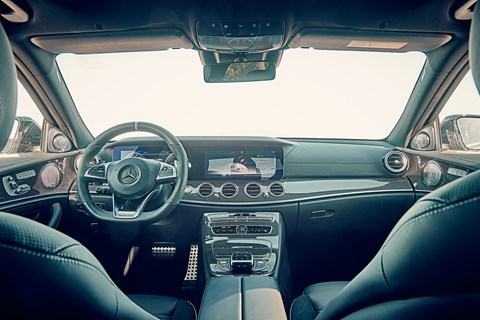
In Race, with ESP switched off and the transmission locked in manual mode, all the power and all the torque is diverted to the rear wheels. Which yell for help and send smoke signals to the Portuguese sky, but to no avail. Up to 75mph, it’s on the driver – and only on the driver – to tame this 604bhp crackerjack. Beyond 75mph, the front axle rejoins the jam session, and the band begins to play a faster tune again.
In contrast to the Merc, rear-wheel drive is not mph-governed in the M5. And it’s only the BMW that wraps up the two preferred dynamic configurations and lets you tap them ad hoc via two red M1 and M2 buttons riding on the steering wheel hub. So while setting them in the first place is a bit of a distraction and faff, your favourites are then on-call 24/7.
BMW claims that the new eight-speed auto matches the shift times of the previously used seven-speed dual-clutcher. This may be so, but the memory chip inside my head misses the whiplash upshifts in the fastest of the three gear-changing velocities. While the AMG employs a wet take-off clutch to shoot out of the starting blocks like greased lightning, the solution applied by the M wizards locks the converter clutch immediately after take-off for maximal momentum and minimal slip.
But while both four-door rocketships can accelerate in an identical 3.4sec from 0-62mph, the M5 edges the 0-124mph sprint with 11.1sec to 11.5sec. How come? Because the longer-legged nine-speed transmission fitted to the car from Stuttgart makes one more upshift. That’s a margin that should stretch when the M5 Competition arrives later in 2018.
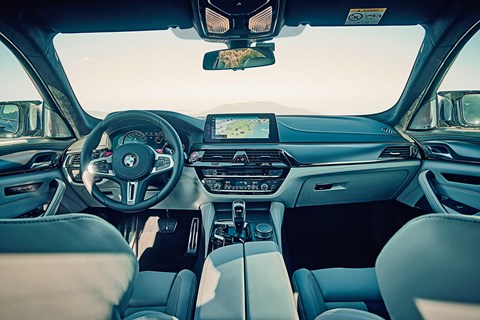
Both test cars were fitted with optional carbon ceramic brakes which are dispensable on the road. Especially in autumn and winter, they rarely operate in the desired temperature window, and the performance in the rain tends to be ambivalent as insufficient initial bite is typically followed by sudden and extreme deceleration. Chafing and droning noises can also be an issue. On the circuit, however, the composite stoppers are a significant confidence-inspiring asset. It’s not only the absolute stopping power that makes a big difference but the absolutely constant pedal pressure and travel as well as the complete absence of brake fade.
On a tyre-devouring track like Estoril, you keep recalibrating the braking and turn-in points as you move along. As far as the brake balance is concerned, the blue car performs on the same high level as the grey car. In the final analysis, it’s primarily the tyres that limit the deceleration potential, not the rotors or the calipers.
The latest E63 S is a very fine piece of kit, but in certain areas it is not quite as well honed as the new M5. One important point in favour of the BMW is its steering. The variable-effort rack operates with commendable precision, balance and agility. Steering angle and steering effort work in total harmony, even when you start changing the settings named Comfort, Sport and Sport Plus.
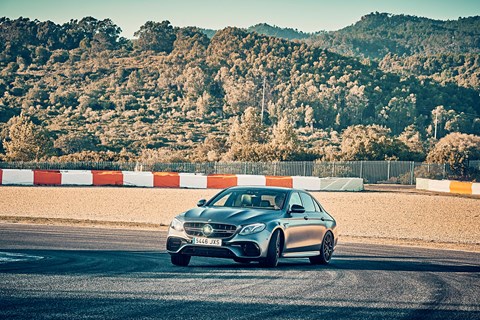
The Mercedes’ steering feels meaty and switched on, but the self-centring motion is somewhat exaggerated. In addition, it takes a more conscious turn at the wheel to dial in lock. Wind on more, and the feedback starts to blur just a touch. When the tail eventually swings round, the steering response is quite light until you reach the point when an invisible counterweight tells the palms in no unclear terms that the next move may be Game Over. In certain situations this system just feels too clever for its own good, where the direction-finder of the M5 is more linear, and its response has more depth.
Browse secondhand Mercedes-Benz E-class for sale
So while this is a dead heat in terms of engine, transmission and braking finesse, the M5 wins the steering sweepstakes by a narrow margin. And it further extends this lead when it comes to the chassis department. A brief glance at the well used rear tyres provides some illumination. While the BMW’s Pirelli P Zeros are evenly shaved off right down to the wear indicators, the Merc’s Conti SportContacts show an asymmetrical degeneration from the crown area all the way to the outside shoulder, in the rear more so than in the front.
This is allegedly down to the more aggressive suspension settings, which spice up toe-in and negative camber. In theory, such a set-up allows higher cornering speeds. In reality the advantage expires at the breakaway point, where grip lets go rather abruptly. You can of course overdrive this peculiarity by stepping hard on the loud pedal, making the rear tyres smear over the surface with noisy enthusiasm.
Mind you, these are only first impressions that need to be backed up by more laps on other circuits. But here in Portugal, the 20 inchers fitted to the M5 seem to sit flatter on the road, and when they let go they do so in a more progressive fashion, fusing car and driver to a confidence-inspiring whole.
We’re not talking about what’s happening in full drift here, but about the difference in pre-climax attitudes, how the chassis reacts as you tip-toe up to the higher limits of these all-wheel-drive super saloons. Even though the Mercedes is equipped with a new triple-chamber air suspension, any trace of cushiness is absorbed by the firm dampers, and that’s before you select Sport or Sport Plus.

The BMW offers a broader span of calibrations from reasonably comfortable to positively firm. It is the slightly less radical of the two contenders, sharp yet more accessible along the cutting edge of the laws of physics. The mission of the exhaust button gets straight to the heart of the matter. Hit it in the E63 S, and its tone of voice changes from Tarzan to King Kong. Hit it in the M5, and the black box turns down the volume.
After a day of non-stop driving on both road and track, splitting M5 from E63 S remains an incredibly tough choice. For a start, both genetically hyped-up four-doors are very good cars. That’s good as in fast, entertaining and communicative too. Although the M5 is the new kid on the block and comes decorated with plenty of advance laurels, the defending champion puts up a hard fight. And it has a lot going for it, like mean looks and a loud voice, the more brutal way of addressing all things dynamic, or the fact that it is also available in estate car guise. The E63 S is about as rough and raw as the sub-brand wants to go.
In contrast, the M5 looks less butch and is less butch. It comes across as the more homogeneous driving machine, sweeter at the limit, always tactile and composed, a tad more compliant, pleasantly relaxed at five tenths yet totally switched on when it really matters. The BMW M5 wins this battle, if only by a short head.
Read more comparison tests by CAR magazine here
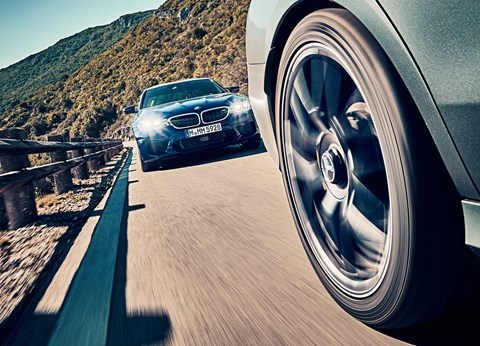
BMW M5 specs
Price £89,640
Engine 4395cc 32v twin-turbo V8, 592bhp @ 5600rpm, 553lb ft @ 1800rpm
Transmission 8-speed auto, all-wheel drive
Performance 3.4sec 0-62mph, 155mph (limited), 26.9mpg, 241g/km CO2
Weight 1855kg
On sale Now
Mercedes-AMG E63 S specs
Price £87,375
Engine 3982cc 32v twin-turbo V8, 604bhp @ 5750rpm, 627lb ft @ 2500rpm
Transmission 9-speed auto, all-wheel drive
Performance 3.4sec 0-62mph, 155mph (limited), 30.7mpg, 209g/km CO2
Weight 1880kg
On sale Now